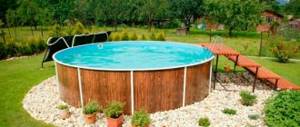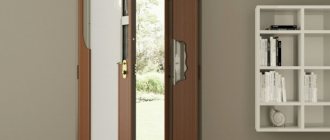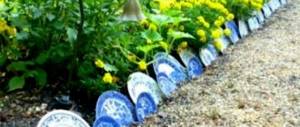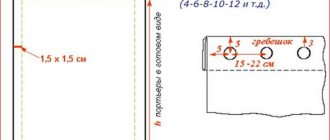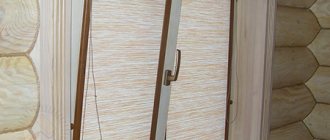A decorative fence with your own hands will help decorate your garden plot and give your flower beds and flower beds a complete, original look. Fences for flower beds can not only transform the landscape of the garden, but also perform other useful functions:
- Aesthetics.
Flower beds and flower beds bordered by a decorative fence look neat and beautiful. Plastic decorative fence for a garden flower bed - Zoning the territory and creating a unified style on the site.
- Plant growth inhibition. Flowers grow within established boundaries.
- Plant protection. Fences help protect garden plantings from accidental damage and trampling by pets.
- A fenced flower garden or flower bed is easier to care for.
Depending on the purpose of the fence, the type of plants, as well as the overall design of the garden, the height and design of the fence are selected:
- A low fence between the flowers and the lawn will fully cope with its barrier function.
- A higher fence is needed to protect flower beds from small children and pets; the height of the fence starts from 40 cm.
- Burying the fence into the ground is necessary for plants that reproduce by root suckers. A fence dug into the ground will also rid the flower garden of weeds.
- A raised fence should be made of durable materials that can support the weight of overhanging plants.
An example of a raised decorative fence for a flower bed
The range of ready-made garden fencing is very large. However, if you show a little imagination, a decorative fence made by yourself can please you even more than the most beautiful modern products. There are practically no restrictions on the options for making fences for flower beds. Let's consider the simplest options from traditional and not so traditional materials.
Return to contents
Wooden fences
Wood is a classic option, the most affordable and in demand. In addition, it is one hundred percent environmentally friendly material that will not harm plants or the earth. On the contrary, slowly decomposing wood will nourish the soil and plants.
Decorative fence for a flower bed made of sawn logs
To decorate flower beds and flower beds with wooden fences, you can use boards, beams, small stumps, stakes, twigs, bars, saw cuts, etc.
Return to contents
Types of wooden fences
- Low picket fence front garden. For the fencing you will need cutting boards or picket fences, bars with a small cross-section, and support posts. Installation is simple - the pillars are dug in around the perimeter of the flowerbed, bars or boards are nailed to them horizontally, and the picket fence itself, previously sawn to the required length, is installed. The finished flower bed can be painted any color. Instead of a picket fence, you can use the remains of the lining;
- A fence made of chocks. Let's look at how to make a decorative fence from thin logs. Chocks can be installed exactly along one line or have different heights, which looks very interesting. The logs can be sharpened and driven into the ground, or placed in a dug trench and compacted well. When cutting chocks, it should be taken into account that about 20 cm will remain underground.
The finished fence can be painted or left in its natural form.
Important! The wood must be treated with an antiseptic, especially the parts in contact with the ground, so the decorative fence will last longer.
Return to contents
Advantages and disadvantages
Wooden fencing has many positive characteristics:
- environmental friendliness and safety of natural materials;
- affordable price;
- high decorative properties of a wooden fence;
- simple installation and easy processing;
- variety of design solutions;
- versatility.
A selection of patterns for decorative wooden fences
The disadvantages of a wooden fence include:
- The need for processing and periodic maintenance. Wood must be treated with protective antiseptics and these procedures must be repeated every 2-3 years.
- Fragility. Wood is inferior in this regard to fences made of concrete, stone or brick.
- Susceptibility to various biological damage: rot, mold, fungus.
- Fire hazard. Without special treatment, wood is a highly flammable material.
Return to contents
Wicker fences
Wicker flower beds and fences for the garden fit organically into the rustic style, and the plants in such flower beds look especially cute. The work itself of creating a wicker fence with your own hands will bring a lot of pleasure. To work you will need any flexible branches:
- and you;
- hazel;
- willows;
- grape vines;
- raspberries;
- cherries.
An example of a wicker fence for a summer house
It is best to prepare material for wicker flower beds in early spring; at this time, the rods have good flexibility and are better cleared of bark. If the branches are not flexible enough, they are soaked in hot water.
Return to contents
Wicker fence installation
- Along the perimeter of the fence, stakes of the required height and the same diameter are driven in. In order for the fence to be more durable, the distance between the supports should not be too large.
- The branches go around the pegs in alternation: if one pole is braided from the outside, then the next one is braided from the inside. It is better to weave from the end of the fence where the beginning of the work will be less noticeable. Weaving the second row is done in reverse; if the column is braided on the outside, the next branch should be on the inside. Each row is tapped with a hammer.
The process of making a section of wicker fence
- The branches at the ends of the fence are nailed to the supports with small nails. The lower and upper branches are tied to the supports with wire for reliability. This way the lower rod will not fall down and the upper rod will not jump out of the fence.
Tip: when weaving, you can take branches one at a time or several at a time. Very thin branches are often woven into bunches to create a beautiful chess pattern.
Wicker fences for flowers can be made in the form of a border, a fairly high fence, or in the shape of a basket. You can make a raised flower bed out of wattle fence. To do this, the sides of the flowerbed need to be protected with plastic film, drainage in the form of crushed stone and sand should be placed on the bottom and soil should be poured.
Return to contents
Types of picket fence
Wooden picket fence is attractive for its casual style and natural appearance, it is easy to install and it is not difficult to make changes to the finished fence design. A picket fence is always recognizable, but unique.
Option for decorating and installing a wooden picket fence
This can be a simple inexpensive fence, a neat fence in a rustic style, or an elite designer fence made from expensive types of wood.
- A budget option. An unedged, unplaned board is used. Often the picket fence is not the same height, and the fence is not painted. The cost of such a fence is low, and rotted boards can also be easily and inexpensively replaced.
- Traditional picket fence. The fence is made from edged boards - it can be unplaned or planed. Often the top of a decorative picket fence is sharpened in the shape of a triangle, rounded, and shaped cuts are made.
- Picket fence made of planed boards. A more expensive version of the classic wooden fence. The material for the fence is well dried, sanded and impregnated with protective compounds for wood.
- A picket fence made from industrially impregnated and painted boards. The most durable option is a warranty period of 20 years.
Such a fence does not require additional or preventive maintenance. - Designer option. The picket fence does not have to be of strict shape. Wood is a material that can easily be given any shape, which is what designers use. A picket fence for a wooden fence can have a rather bizarre shape and additional decoration.
- Combined picket fence. The fence can be made in various combinations: on a poured foundation, with a high base and various support pillars. The picket fence is especially good in combination with stone. Installing a wooden fence on the foundation will extend the life of the fence for a long time and protect the pickets from rotting, which usually begins at the bottom when in contact with the ground.
Return to contents
Brick fence
Brick as borders for flower beds in the garden is one of the popular options. The design of a brick fence can be very different. There are many advantages to such a fence:
- Attractiveness. Unless, of course, it’s not an old crumbling brick, but, for example, a solid colored version;
- A brick border looks organically with the brick walls of the house and plants;
- Strength. The brick curb is durable even without the use of cement;
- A brick dug into the ground protects flower beds well from weeds.
Return to contents
DIY brick flowerbed border
- Marking. The contour of a brick flower bed can be anything: straight, round, concave, with bends.
- Preparing the trench. A shallow ditch is dug along the perimeter of the flower bed, about 15 cm deep and about 25 cm wide.
- Installing a flowerbed border. Brickwork is laid, secured with cement mortar. You can lay out bricks in different ways; the main thing is to ensure the strength and evenness of the fence.
- The solution should dry within 3 - 5 days and the flower garden can be used for its intended purpose.
The process of making a brick flower bed
Return to contents
How to choose the right material for a fence
First you need to decide on the type of material for the picket fence:
- Unedged board is the cheapest option. The edges of such a picket fence are not cleared of bark. The material parameters are 6 m in length and from 10 to 50 cm in width. Another feature of unedged material is high humidity. To avoid cracking and deformation of the fence, the material must first be dried under natural conditions.
- Edged board - the boards are cut and most often already planed. Edged boards also have a high percentage of humidity and require additional drying. Product dimensions: width - 10 - 15 cm, thickness 2 - 2.5 cm, length 5 - 6 m.
- A finished fence board is the most expensive material that can be used for its intended purpose immediately. The material is dried to an optimal humidity of 12 - 15%. The boards are cut to length - 2, 2.5 and 3 m and sanded.
The finished picket fence can have a straight top cut or a shaped one. Boards with a figured top will cost more.
If you want to save money, you don’t have to choose kiln-dried wood. If the quality of the picket fence is good, it can be dried at home. To prevent the boards from deforming, they are laid on a flat surface and pressed down with something heavy.
Return to contents
Wood species
When choosing wood for fencing, you should choose varieties with a dense structure:
- pine;
- larch;
- alder;
- ash;
- oak.
The most affordable option is pine - it is a fairly reliable and durable wood for a fence. Larch is considered the best, which is twice as expensive as pine, but also surpasses it in durability and strength.
Oak is elite and expensive - it is resistant to moisture, mechanical stress and is practically “eternal”. The oak picket fence looks very solid and has a beautiful wood pattern.
Return to contents
Signs of low-quality wood
Before purchasing, you should carefully inspect the material; the following signs indicate poor quality of the material:
- blackening, blueness and other unnatural staining of the wood surface;
- strong humidity (noticeable to the touch);
- traces of mold;
- cracks;
- remnants of bark (if this is a trimmed version);
- non-standard and non-compliance with the stated parameters;
- large knots;
- uneven cutting surface.
High-quality lumber is distinguished by a light shade and smooth surface. The wood grain should be parallel to the picket fence.
Return to contents
Decorative fences made of natural stone
Garden fencing made of natural stone is beauty, harmony and durability. You can create beautiful flower beds and flower beds from natural materials. You can use any mineral for a garden fence: pebbles, granite, sandstone, dolomite, marble. You can make the following types of decorative fencing with your own hands from stone:
- Simple laying in one row. The easiest way to arrange flower beds is to lay stone around the perimeter of the fence.
- Laying in several rows. To get a tall and more noticeable flower bed made of stone, it can be laid in several rows. It is more convenient to use flat slate for work. A trench is dug under the base of the stone fence, which can be filled with cement to create a small foundation. The stone is laid using cement. To make the masonry even, you need to mark the place of the flower bed and stretch the guide twine.
The process of laying a stone fence for a flower bed
Usually the stones are fastened with cement closer to the inside of the fence, so that the effect of dry masonry without mortar remains on the outside.
- Spiral flower bed made of stone. A multi-tiered spiral flowerbed is an interesting solution for the garden. Gradually adding soil, the stones are laid out so that the highest point is formed in the center of the round flowerbed. At the top of such a flower bed, heat-loving flowers will feel good.
Return to contents
Proper design of flower beds
Many novice gardeners build picturesque hedges for flower beds from scrap materials in a touching Provence or country style.
A fence made of twigs, pegs or logs is very cute and fits organically into the landscape. Wood is warm and hardly freezes like stone or metal, which means it will protect plant roots from freezing. By the way, its installation is simple and quick, and repairs will not require any expense or special effort.
Willow flowerbed fence
Charming fences for flower beds
Wicker elements:
- A low wattle fence is easy to make even for a novice gardener, capturing the natural beauty of the willow tree. Weaving lessons can be learned from videos on the Internet - today even children's websites teach how to weave baskets and rugs.
- We prepare the rods in early spring, when the bark is easily removed.
- We will drive pegs 3 cm in diameter around the perimeter of the flower bed.
- The more often the pegs are driven in, the stronger the fence.
- Then we braid them.
- After the 4th row, compact the resulting weave with a hammer.
- We nail the ends of the twigs to the pegs.
Decorating flower beds with logs
Easy to assemble, but durable and original flowerbed fence
It's easy to make a cute wooden decorative fence for your flowerbed with your own hands.
- We make it from half-meter logs, which will go 20 cm into the ground.
- Let's dig a shallow ditch around the flowerbed and place logs there.
- Then we will bury the bottom of the logs and compact them.
Note! If you clean the logs from the bark and paint them with a special composition for wood, the fence will last 50 years.
Miniature wooden fence
Decorative fencing made from boards is very pleasant, as we see in the photo
Self-production:
- First, we will make figured or triangular tops on the blank strips.
- We fasten them with transverse boards into a convenient section.
- We dig the posts at a distance corresponding to the size of one section.
- We will nail the sections onto the posts.
- We will paint the finished fence with oil paint to protect it from rain and snow.
Pergons and gabions
Natural stone in a welded mesh allows you to create flower beds and fences for a garden of any height. Multi-tiered or tall flower beds made from gabions look great in combination with the natural landscape.
Installing such a fence is also not difficult. You need to assemble a box from a welded mesh and fill it with any stone, the main thing is that the size of the backfill matches the mesh cells.
You can install a structure made of stone and mesh on any base. Rack rods with a diameter of about 8 mm are used as the base.
The grate can be made from galvanized steel rods with a cross-section of 5 mm. In addition to stone, other materials may be present in the structure: tree cuts, glass, brick, concrete. After installing the flowerbed, its walls are lined with geotextiles, and soil is poured into which flowers can be planted.
Return to contents
Garden fences made of corrugated sheets and slate
From the remnants of roofing materials, you can build quite a decent fence for flower beds and flower beds, which will cope well with its main tasks.
Installation of such a fence is as simple as possible:
- A narrow, shallow ditch is dug.
- Strong pegs or pieces of reinforcement are driven in along the perimeter of the fence.
An example of a slate fence for a garden bed or flower bed
- Sheet material is installed in the trench. In this case, the sheet should rest on the protruding bars. From corrugated sheet metal, which bends well, you can make curved flower beds.
- The trench is dug and the soil is compacted well.
Return to contents
Making a decorative fence with your own hands
There are several options for making a picket fence.
Boardwalk
First, let's look at how you can make a board fence yourself, which is optimal for a summer house or garden. You can assemble it from scrap boards.
First, you need to strengthen wooden supports in the ground at an equal distance from each other.
Next, you need to attach a board to the top of the support so that it does not protrude beyond its edge.
Photo:
Also, other boards are mounted at an equal distance from each other, right down to the surface of the earth.
Despite its apparent simplicity, such a fence will help protect the territory of the garden or dacha from outside encroachments, and in addition, it will look original, giving the site a finished look.
Wicker
A wicker fence would be an excellent solution for a summer house, as well as for fencing flower beds.
You can do it yourself, and in a short period of time. It will require a certain number of branches.
Birch, willow, and apple tree twigs are suitable. It is best to cut them in spring or summer, and their thickness, according to the rules, should not exceed two centimeters.
The number of available materials and rods used is determined directly by the length of the structure.
First, you need to dig in vertical supports with a certain step. After this, you can start weaving starting from the bottom row.
Each row of twigs and branches must be secured to the support using branches. Such a wicker fence will perfectly protect the flower beds from encroachment from the outside.
From a picket fence
Quite often you can find original fencing made of picket fences. With its help, they protect not only flower beds, but also the entire local area.
This wooden fence is quite durable and copes well with its main function. You can assemble a picket fence yourself in a short time.
To make it you need a minimum of available materials. All work begins with the installation of supports at an equal distance from each other. Next, guide rails should be nailed to these supports.
After this, you can begin installing the picket fence itself, which is mounted at a minimum distance from each other.
A picket fence will be an excellent decoration for a flower bed, and in addition, it will give the entire area a finished look.
Green fence for the garden
Plants with a rigid crown that are easy to shape can be used as hedges in the country. Low borders for flower beds are formed from small-leaved, low-growing plants such as boxwood, rosemary, and shiny honeysuckle.
The advantage of such “green” fences is their absolute naturalness and harmony with the environment. Once a living flower bed has established itself, it is quite easy to care for. You just need to periodically trim the growing fence.
Return to contents





